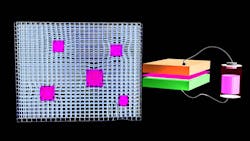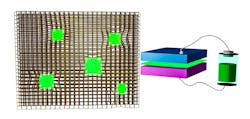Nanomaterial Added to LEDs Improves Efficiency and Brightness
Team of researchers from several national labs, including Argonne, Brookhaven, Los Alamos and the SLAC National Accelerator Lab, as well as engineers from Academia Sinica in Taiwan, have managed to stabilize perovskite nanocrystals for use in LEDs. This should lead to better LEDs with substantial improvements in brightness and stability, according to Xuedan Ma, scientist in Argonne’s Center for Nanoscale Materials.
Perovskites share a particular crystalline structure that gives them light-absorbing and light-emitting properties that can be helpful in designing and delivering a range of energy-efficient applications, including solar cells, consumer devices and various gamma detectors.
Perovskite nanocrystals have long been prime candidates as a promising LED material, but testing they proved them unstable. To stabilize them the research team embedded the nanocrystals in a porous structure, a metal-organic framework (MOF).
“The intriguing concept of combining perovskite nanocrystal in MOF had been demonstrated in powder form, but this is the first time it has been used to create the emission layer in an LED,” says Hsinhan Tsai, a former J.R. Oppenheimer postdoc fellow at Los Alamos.
Previous attempts to create nanocrystal LEDs went awry when the nanocrystals degraded back to their unwanted bulk phase, losing their nanocrystal advantages and undermining their advantages in practical LEDs. Bulk materials consist of billions of atoms. Materials such as perovskites in the nano phase are made of groupings of just a few to a few thousand atoms, and thus behave differently.
To make the MOF, the team used lead nodes in the framework as the metal precursor and halide salts as the organic material. The halide salts contain methylammonium bromide, which reacts with lead in the framework to build nanocrystals around the lead core trapped in the matrix. The matrix keeps the nanocrystals separated, so they don’t interact and degrade. This method is based on a coating approach which is far less expensive than vacuum processing, which is currently used to create the inorganic LEDs widely used today.
The MOF-stabilized LEDs can be fabricated to create bright red, blue, and green light, along with varying shades of each. “In this work, we demonstrated for the first time that perovskite nanocrystals stabilized in a MOF will create bright, stable LEDs in a range of colors,” says Wanyi Nie, scientist at Los Alamos. “We can create different colors, improve color purity, and increase the photoluminescence quantum yield, a measure of a material’s ability to generate light.”
Key to the team’s efforts were its access to the Advanced Photon Source (APS) at Argonne to carry out time-resolved X-ray absorption spectroscopy, a technique that let the researchers spot the changes in the perovskite material over time. Researchers could track electrical charges as they moved through the material and learned much more about what happens when the material emits light.
In durability tests, the new material performed well despite exposure to UV radiation, heat and an electrical field, and did not degrade or losing its light-detecting and light-emitting efficiency. This was a key condition for practical applications such as TVs and radiation detectors.

